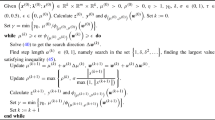Abstract
Dual-feasible functions are valuable tools that can be used to compute both lower bounds for different combinatorial problems and valid inequalities for integer programs. Several families of functions have been used in the literature. Some of them were defined explicitly, and others not. One of the main objectives of this paper is to survey these functions, and to state results concerning their quality. We clearly identify dominant subsets of functions, i.e. those which may lead to better bounds or stronger cuts. We also describe different frameworks that can be used to create dual-feasible functions. With these frameworks, one can get a dominant function based on other ones. Two new families of dual-feasible functions obtained by applying these methods are proposed in this paper.
We also performed a computational comparison on the relative strength of the functions presented in this paper for deriving lower bounds for the bin-packing problem and valid cutting planes for the pattern minimization problem. Extensive experiments on instances generated using methods described in the literature are reported. In many cases, the lower bounds are improved, and the linear relaxations are strengthened.
Similar content being viewed by others
References
Aardal, K., & Weismantel, R. (1997). Polyhedral combinatorics. New York: Wiley.
Alves, C., & Valério de Carvalho, J. M. (2008). A branch-and-price-and-cut algorithm for the pattern minimization problem. RAIRO Operations Research, 42, 435–453.
Baldacci, R., & Boschetti, M. (2007). A cutting plane approach for the two-dimensional orthogonal non guillotine cutting stock problem. European Journal of Operational Research, 183, 1136–1149.
Boschetti, M. (2004). New lower bounds for the three-dimensional finite bin packing problem. Discrete Applied Mathematics, 140, 241–258.
Boschetti, M., & Mingozzi, A. (2003a). The two-dimensional finite bin packing problem. Part I: New lower bounds for the oriented case. 4OR, 1, 27–42.
Boschetti, M., & Mingozzi, A. (2003b). The two-dimensional finite bin packing problem. Part II: New lower and upper bounds. 4OR, 1, 135–147.
Burdett, C. A., & Johnson, E. L. (1977). A subadditive approach to solve linear integer programs. Annals of Discrete Mathematics, 1, 117–144.
Caprara, A., & Monaci, M. (2007) Bidimensional packing by bilinear programming. Mathematical Programming. doi:10.1007/s10107-007-0184-7.
Carlier, J., & Néron, E. (2000). A new LP-based lower bound for the cumulative scheduling problem. European Journal of Operational Research, 127, 363–382.
Carlier, J., & Néron, E. (2003). On linear lower bounds for the resource constraint project scheduling problem. European Journal of Operational Research, 149(2), 314–324.
Carlier, J., & Néron, E. (2007). Computing redundant resources for the resource constrained project scheduling problem. European Journal of Operational Research, 176(3), 1452–1463.
Carlier, J., Clautiaux, F., & Moukrim, A. (2007). New reduction procedures and lower bounds for the two-dimensional bin packing problem with fixed orientation. Computers and Operations Research, 34(8), 2223–2250.
Chvátal, V. (1973). Edmonds polytopes and a hierarchy of combinatorial problems. Discrete Mathematics, 4, 305–337.
Clautiaux, F. (2005) Bornes inférieures et méthodes exactes pour le problème de bin-packing en deux dimensions avec orientation fixe. PhD thesis, Université de Technologie de Compiègne, France.
Dash, S., & Günlük, O. (2006). Valid inequalities based on simple mixed-integer sets. Mathematical Programming, 105, 29–53.
Fekete, S., & Schepers, J. (2001). New classes of fast lower bounds for bin packing problems. Mathematical Programming, 91, 11–31.
Fekete, S., & Schepers, J. (2004). A general framework for bounds for higher-dimensional orthogonal packing problems. Mathematical Methods of Operations Research, 60, 311–329.
Garey, M. R., & Johnson, D. S. (1979). Computers and intractability, a guide to the theory of NP-completeness. New York: Freeman.
Gau, T., & Waescher, G. (1995). CUTGEN1: A problem generator for the standard one-dimensional cutting stock problem. European Journal of Operational Research, 84, 572–579.
Gilmore, P., & Gomory, R. (1961). A linear programming approach to the cutting stock problem. Operations Research, 9, 849–859.
Gilmore, P., & Gomory, R. (1963). A linear programming approach to the cutting stock problem—part II. Operations Research, 11, 863–888.
Gomory, R. (1958). Outline of an algorithm for integer solutions to linear programs. Bulletin of the American Mathematical Society, 64, 275–278.
Lasserre, J. B. (2005). Integer programming, duality and superadditive functions. Contemporary Mathematics, 374, 139–150.
Letchford, A. N., & Lodi, A. (2002). Strengthening Chvátal-Gomory cuts and Gomory fractional cuts. Operations Research Letters, 30, 74–82.
Lueker, G. S. (1983). Bin packing with items uniformly distributed over intervals [a, b]. In Proc. of the 24th annual symposium on foundations of computer science (FOCS 83) (pp. 289–297). Silver Spring: IEEE Computer Society.
Martello, S., & Toth, P. (1990). Knapsack problems—algorithms and computer implementation. Chichester: Wiley.
Nemhauser, G. L., & Wolsey, L. A. (1999). Integer and combinatorial optimization. New York: Wiley-Interscience.
Vanderbeck, F. (2000). Exact algorithm for minimizing the number of setups in the one-dimensional cutting stock problem. Operations Research, 46(6), 915–926.
Wäscher, G., Haussner, H., & Schumann, H. (2007). An improved typology of cutting and packing problems. European Journal of Operational Research, 183, 1109–1130.
Author information
Authors and Affiliations
Corresponding author
Rights and permissions
About this article
Cite this article
Clautiaux, F., Alves, C. & Valério de Carvalho, J. A survey of dual-feasible and superadditive functions. Ann Oper Res 179, 317–342 (2010). https://doi.org/10.1007/s10479-008-0453-8
Published:
Issue Date:
DOI: https://doi.org/10.1007/s10479-008-0453-8




